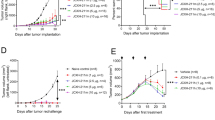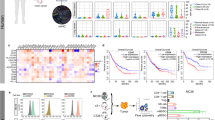Abstract
Interleukin-15 (IL15) is a potential immunotherapeutic treatment for cancer. Caspy2 is an active zebra caspase for inducing apoptosis and immune response in murine tumors. In this study, we aim to evaluate the potential of gene therapy using IL15 and Caspy2 against the murine tumors. Plasmid expressing both Caspy2 and IL15 genes was constructed, encapsulated in DOTAP/cholesterol cationic liposome and injected intratumorally into the mice bearing CT26, B16-F10 and 4T1 carcinoma. We found that coexpression of IL15 and Caspy2 could significant inhibit tumor growth and prolong survival of the mice bearing CT26 or B16F10 tumor. A significant reduction in spontaneous lung metastasis was observed in the 4T1 tumor model. In CT26 model, the mice treated with IL15 and Caspy2 acquired a long-time protective immunity against the parental tumor cell rechallenge. Cytotoxic T lymphocytes and terminal deoxynucleotidyltransferase-mediated nick end labelling assays showed that the combination of capsy2 and IL15 could enhance both the apoptosis and immune response induction, which may account for its extraordinary antitumor effect. Furthermore, we showed that the observed tumor suppression by IL15 and Caspy2 concurred with the Caspy2-mediated downregulation of IL10 and upregulation of interferon-γ and tumor necrosis factor-α. Our results therefore suggested that the combination regimen might be a novel and effective strategy for cancer treatment.
This is a preview of subscription content, access via your institution
Access options
Subscribe to this journal
Receive 12 print issues and online access
$259.00 per year
only $21.58 per issue
Buy this article
- Purchase on Springer Link
- Instant access to full article PDF
Prices may be subject to local taxes which are calculated during checkout






Similar content being viewed by others
References
Jakobisiak M, Golab J, Lasek W . Interleukin 15 as a promising candidate for tumor immunotherapy. Cytokine growth factor rev 2011; 22: 99–108.
Kennedy MK, Glaccum M, Brown SN, Butz EA, Viney JL, Embers M et al. Reversible Defects in Natural Killer and Memory Cd8 T Cell Lineages in Interleukin 15-Deficient Mice. J Exp Med 2000; 191: 771–780.
Waldmann TA . The biology of interleukin-2 and interleukin-15: implications for cancer therapy and vaccine design. Nat Rev Immunol 2006; 6: 595–601.
Fehniger TA, Caligiuri MA . Interleukin 15: biology and relevance to human disease. Blood 2001; 97: 14–32.
Oh S, Perera LP, Terabe M, Ni L, Waldmann TA, Berzofsky JA . IL-15 as a mediator of CD4+ help for CD8+ T cell longevity and avoidance of TRAIL-mediated apoptosis. Proc Natl Acad Sci 2008; 105: 5201–5206.
Kanegane H, Tosato G . Activation of naive and memory T cells by interleukin-15. Blood 1996; 88: 230–235.
Wilkinson PC, Liew FY . Chemoattraction of human blood T lymphocytes by interleukin-15. J Exp Med 1995; 181: 1255–1259.
Fehniger TA, Yu H, Cooper MA, Suzuki K, Shah MH, Caligiuri MA . Cutting Edge: IL-15 Costimulates the Generalized Shwartzman Reaction and Innate Immune IFN-γ Production In Vivo. J Immunol 2000; 164: 1643–1647.
Ugen KE, Kutzler MA, Marrero B, Westover J, Coppola D, Weiner DB et al. Regression of subcutaneous B16 melanoma tumors after intratumoral delivery of an IL-15-expressing plasmid followed by in vivo electroporation. Cancer Gene Ther 2006; 13: 969–974.
Teague RM, Sather BD, Sacks JA, Huang MZ, Dossett ML, Morimoto J et al. Interleukin-15 rescues tolerant CD8+ T cells for use in adoptive immunotherapy of established tumors. Nat Med 2006; 12: 335–341.
Epardaud M, Elpek KG, Rubinstein MP, Yonekura A-R, Bellemare-Pelletier A, Bronson R et al. Interleukin-15/Interleukin-15Rα Complexes Promote Destruction of Established Tumors by Reviving Tumor-Resident CD8+ T Cells. Cancer Res 2008; 68: 2972–2983.
Kobayashi H, Dubois S, Sato N, Sabzevari H, Sakai Y, Waldmann TA et al. Role of trans-cellular IL-15 presentation in the activation of NK cell-mediated killing, which leads to enhanced tumor immunosurveillance. Blood 2005; 105: 721–727.
Zhou X, Li X, Gou M, Qiu J, Li J, Yu C et al. Antitumoral efficacy by systemic delivery of heparin conjugated polyethylenimine–plasmid interleukin-15 complexes in murine models of lung metastasis. Cancer Sci 2011; 102: 1403–1409.
Zhang M, Yao Z, Dubois S, Ju W, Müller JR, Waldmann TA . Interleukin-15 combined with an anti-CD40 antibody provides enhanced therapeutic efficacy for murine models of colon cancer. Proc Natil Acad Sci 2009; 106: 7513–7518.
Yu P, Steel JC, Zhang M, Morris JC, Waldmann TA . Simultaneous Blockade of Multiple Immune System Inhibitory Checkpoints Enhances Antitumor Activity Mediated by Interleukin-15 in a Murine Metastatic Colon Carcinoma Model. Clin Cancer Res 2010; 16: 6019–6028.
Cao S, Cripps A, Wei MQ . New strategies for cancer gene therapy: Progress and opportunities. Clin Exp Pharmacol Physiol 2010; 37: 108–114.
Dougan M, Dranoff G . Immune Therapy for Cancer. Annu Rev Immunol 2009; 27: 83–117.
Brown JM, Attardi LD . The role of apoptosis in cancer development and treatment response. Nat Rev Cancer 2005; 5: 231–237.
Takeda K, Yamaguchi N, Akiba H, Kojima Y, Hayakawa Y, Tanner JE et al. Induction of Tumor-specific T Cell Immunity by Anti-DR5 Antibody Therapy. J Exp Med 2004; 199: 437–448.
Epple M, Ganesan K, Heumann R, Klesing J, Kovtun A, Neumann S et al. Application of calcium phosphate nanoparticles in biomedicine. J Mater Chem 2010; 20: 18–23.
Selenko N, Maidic O, Draxier S, Berer A, Jager U, Knapp W et al. CD20 antibody (C2B8)-induced apoptosis of lymphoma cells promotes phagocytosis by dendritic cells and cross-priming of CD8+ cytotoxic T cells. Leukemia 2001; 15: 1619–1626.
Masumoto J, Zhou W, Chen FF, Su F, Kuwada JY, Hidaka E et al. Caspy, a Zebrafish Caspase, Activated by ASC Oligomerization Is Required for Pharyngeal Arch Development. J Biol Chem 2003; 278: 4268–4276.
Liu L, Deng H, Wang Y, Chen P, Yang Y, Yang H et al. A novel strategy for tumour therapy combining cell apoptosis and active immunity induced by caspy2, a zebrafish caspase. J Cell Mol Med 2009; 13 (8b): 2271–2281.
Yang Y, Bai Y, Xie G, Zhang N, Ma YP, Chen LJ et al. Efficient inhibition of non-small-cell lung cancer xenograft by systemic delivery of plasmid-encoding short-hairpin RNA targeting VEGF. Cancer Biother Radiopharm 2010; 25: 65–73.
Wang Y-S, Li D, Shi H-S, Wen Y-J, Yang L, Xu N et al. Intratumoral Expression of Mature Human Neutrophil Peptide-1 Mediates Antitumor Immunity in Mice. Clin Cancer Res 2009; 15: 6901–6911.
Wang Y-S, Wang G-Q, Wen Y-J, Wang L, Chen X-C, Chen P et al. Immunity against Tumor Angiogenesis Induced by a Fusion Vaccine with Murine β-Defensin 2 and mFlk-1. Clin Cancer Res 2007; 13: 6779–6787.
Steeg PS . Tumor metastasis: mechanistic insights and clinical challenges. Nat Med 2006; 12: 895–904.
Smith MCP, Luker KE, Garbow JR, Prior JL, Jackson E, Piwnica-Worms D et al. CXCR4 Regulates Growth of Both Primary and Metastatic Breast Cancer. Cancer Res 2004; 64: 8604–8612.
Skak K, Kragh M, Hausman D, Smyth MJ, Sivakumar PV . Interleukin 21: combination strategies for cancer therapy. Nat Rev Drug Discov 2008; 7: 231–240.
Porter AG, Janicke RU . Emerging roles of caspase-3 in apoptosis. Cell death and differentiation 1999; 6: 99–104.
Acknowledgements
This work was supported by National Natural Science Foundation of China (30973451) and The National Key Basic Research Program (973 Program) of China (2010CB529900 and 2012CB917104).
Author information
Authors and Affiliations
Corresponding author
Ethics declarations
Competing interests
The authors declare no conflict of interest.
Rights and permissions
About this article
Cite this article
Yang, Y., Zhang, Xm., Zhang, N. et al. IL15 combined with Caspy2 provides enhanced therapeutic efficiency against murine malignant neoplasm growth and metastasis. Cancer Gene Ther 19, 460–467 (2012). https://doi.org/10.1038/cgt.2012.17
Received:
Accepted:
Published:
Issue Date:
DOI: https://doi.org/10.1038/cgt.2012.17



